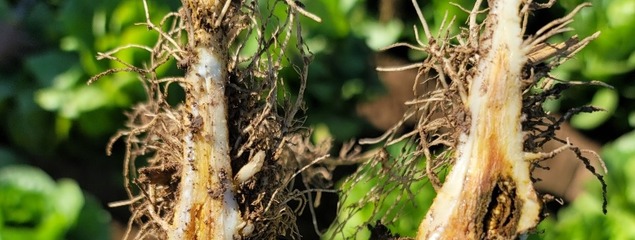
Plant Disease Management
Gray Mold
Gray mold of lettuce occurs most everywhere that lettuce is grown, but its prevalence varies depending on the particular environment of the lettuce production area. The disease affects all lettuce types but is more prevalent in leaf types. Symptoms include wilting and collapse of young seedlings, followed by a wet decay and necrosis. In mature plants, the disease may begin on the upper foliage or at the soil level. In a disease of the upper plant, irregular necrotic spots appear across the mature leaves and may coalesce into larger necrotic areas. In a disease of the base of the plant, wilting and collapse follows the necrosis of the lettuce stem. If the necrotic lettuce plant is turned over, a gray fuzzy mold may be seen across the necrotic area, often with irregularly shaped flattened sclerotia. At this stage, the disease can be mistaken for lettuce drop caused by Sclerotinia sclerotiorum; however, with lettuce drop, the mold will be white and the sclerotia will be irregular and more rounded in shape.
The disease is a common problem in greenhouse production, when ambient moisture may be higher and more constant than that in field production. This occurs both in transplants and in hydroponic production systems. In leaf lettuce production, the disease affects the foliage at all stages of development, resulting in irregular necrotic spots that can coalesce and consume entire leaves. If left untreated, the disease can rapidly spread to all neighboring plants within the growing facility.

